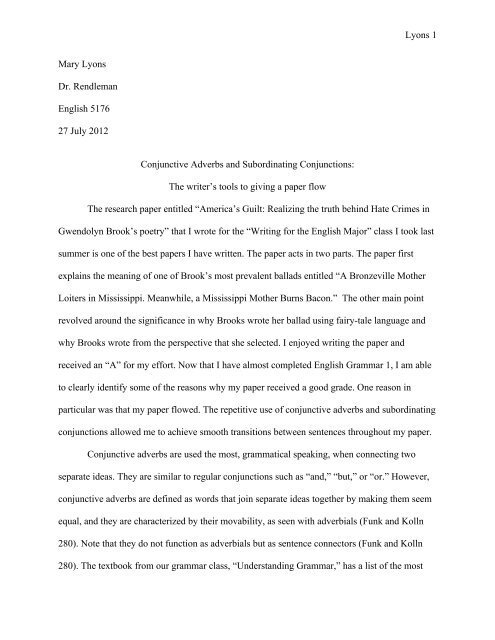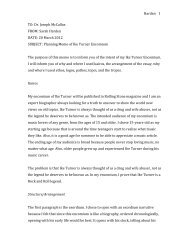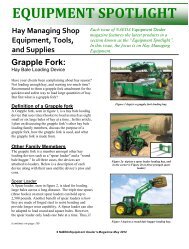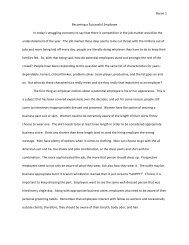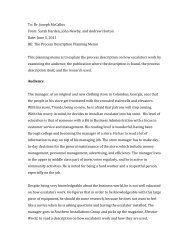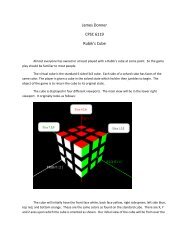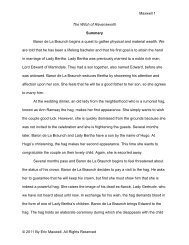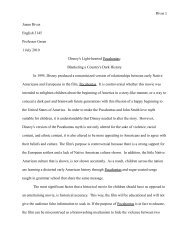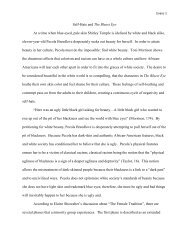Conjunctive Adverbs and Subordinating Conjunctions - studentwebs ...
Conjunctive Adverbs and Subordinating Conjunctions - studentwebs ...
Conjunctive Adverbs and Subordinating Conjunctions - studentwebs ...
Create successful ePaper yourself
Turn your PDF publications into a flip-book with our unique Google optimized e-Paper software.
Lyons 1Mary LyonsDr. RendlemanEnglish 517627 July 2012<strong>Conjunctive</strong> <strong>Adverbs</strong> <strong>and</strong> <strong>Subordinating</strong> <strong>Conjunctions</strong>:The writer’s tools to giving a paper flowThe research paper entitled “America’s Guilt: Realizing the truth behind Hate Crimes inGwendolyn Brook’s poetry” that I wrote for the “Writing for the English Major” class I took lastsummer is one of the best papers I have written. The paper acts in two parts. The paper firstexplains the meaning of one of Brook’s most prevalent ballads entitled “A Bronzeville MotherLoiters in Mississippi. Meanwhile, a Mississippi Mother Burns Bacon.” The other main pointrevolved around the significance in why Brooks wrote her ballad using fairy-tale language <strong>and</strong>why Brooks wrote from the perspective that she selected. I enjoyed writing the paper <strong>and</strong>received an “A” for my effort. Now that I have almost completed English Grammar 1, I am ableto clearly identify some of the reasons why my paper received a good grade. One reason inparticular was that my paper flowed. The repetitive use of conjunctive adverbs <strong>and</strong> subordinatingconjunctions allowed me to achieve smooth transitions between sentences throughout my paper.<strong>Conjunctive</strong> adverbs are used the most, grammatical speaking, when connecting twoseparate ideas. They are similar to regular conjunctions such as “<strong>and</strong>,” “but,” or “or.” However,conjunctive adverbs are defined as words that join separate ideas together by making them seemequal, <strong>and</strong> they are characterized by their movability, as seen with adverbials (Funk <strong>and</strong> Kolln280). Note that they do not function as adverbials but as sentence connectors (Funk <strong>and</strong> Kolln280). The textbook from our grammar class, “Underst<strong>and</strong>ing Grammar,” has a list of the most
Lyons 2commonly used conjunctive adverbs <strong>and</strong> adverbial prepositional phrases. The book breaks themdown into eight categories including the following: “results, concession, apposition, addition,time, contrast, summary, <strong>and</strong> reinforcement” (Funk <strong>and</strong> Kolln 280). Some conjunctive adverbswithin the list are “therefore, consequently, as a result, nevertheless, for example, moreover,furthermore, meanwhile, however, instead, thus, in particular etc.” (Funk <strong>and</strong> Kolln 280).I noticed that in my paper, I often used conjunctive adverbs from the “addition category”to give my paper flow. The words from the “addition category” that I used the most include“also, “likewise,” <strong>and</strong> “further.” Primarily, I used these words to add on to previously statedinformation, but more importantly to stress that the two separate ideas were equal. One instanceof this occurring in my paper is seen when I used “likewise” to say, “The speaker’s guilt spreadsthroughout the poem to the point where it consumes the speaker. Likewise, if America doesn’tchange their actions, guilt has the potential to spread <strong>and</strong> consume the country.” Through the useof “likewise,” I wanted my audience to realize that the speaker was America <strong>and</strong> the guilt theAmericans felt was the same guilt the speaker felt. If I had simply wrote “The speaker’s guiltspreads throughout the poem to the point where it consumes the speaker. If America doesn’tchange their actions, guilt has the potential to spread <strong>and</strong> consume the country,” the secondsentence would almost seem unrelated. And without the transitioning word at the beginning, thesentence would still sound incomplete, as if it needed “too” or “also” at the end. <strong>Conjunctive</strong>adverbs allowed me to connect similar independent thoughts that, at the same time, provided myreaders smooth transitioning.Another way I provided transitioning to assists in the ease of reading for my audiencewas my use of subordinating conjunctions. <strong>Subordinating</strong> conjunctions are defined asconjunctions that join separate ideas together with a purpose of emphasizing one idea over the
Lyons 3other. Similarly to conjunctive adverbs, they can be one word or a phrase <strong>and</strong> are often located atthe beginning or end of the main clause. Unlike conjunctive adverbs, they are not moveable.Once it moves, they are no longer considered a conjunction but a coordinator. “Thecoordinators—the conjunctive adverbs as well as the coordinating conjunctions—introduce onlythe second clause” (Funk <strong>and</strong> Kolln 281). To further emphasize their point, our grammar bookuses the word “because” as example. In the sentence “We decided to walk because we hadmissed the last bus,” the word “because” is used as a coordinator since the word introduces thesecond clause (Funk <strong>and</strong> Kolln 281). But when used in the sentence, “Because we had missed thelast bus, we decided to walk,” the word “because” acts as a conjunction since introduces the firstclause (Funk <strong>and</strong> Kolln 281). Another main difference between the two terms is thatsubordinating conjunctions focuses on drawing relationships through comparison insteadequality. They are also determined by their rule of combining separate ideas in which one of theideas has to be an independent or dependent clause. <strong>Subordinating</strong> <strong>Conjunctions</strong> are alsocharacterized into eight categories including: “time, concession, contingency, condition, reason,result, comparison, <strong>and</strong> contrast” (Funk <strong>and</strong> Kolln 281). The following is a list of the most wellknownsubordinating conjunctions: “when, whenever, after, until, though, although, even though,in case, as long as, because, since, so that, as just, as if, while <strong>and</strong> whereas” (Funk <strong>and</strong> Kolln280).I emphasized comparisons in my paper through the use of subordinating conjunctionsmainly from the “time category.” More specifically, I frequently used “when,” “after,” “as,”“once,” “since,” <strong>and</strong> “while.” As the definition mentioned above, these words are used to drawrelationships in terms of comparisons through cause <strong>and</strong> effect. One example from my paper waswhen I wrote, “Hate crimes have existed for a while, but guilt only began to occur when the
Lyons 4people witnessed the brutality publicized by media.” The emphasis is seen after the first comma,but I really drove my point home with the dependent clause, “when the people witnessed thebrutality publicized by media.” I wanted my readers to make the connection between theawareness of hate crimes with publicized media—one only occurred because of the other. If“when” was taken out, the separate ideas could st<strong>and</strong> alone, but they would seem disconnected.The sentences would lack the transitioning needed to make the two ideas flow: “Hate crimeshave existed for a while. People witnessed the brutality publicized by media, <strong>and</strong> began to feelguilt.” The relationship between the two ideas in the revised sentence is harder to connect <strong>and</strong>would most likely go unrecognizable.The consequences to not having subordinating conjunctions or conjunctive adverbs faroutweigh the benefits. With them, my paper was able to flow smoothly together, <strong>and</strong> allowed meto express my points effectively. While they both mainly function to connect two separate ideas,conjunctive adverbs give emphasis <strong>and</strong> show relationship through equality, while subordinatingconjunctions convey relationships in a manner of comparison through cause <strong>and</strong> effect. In myfuture writings, I plan on continuing to use them. But now that I am able to identify them <strong>and</strong>their use, I will concentrate on using a variety instead of the ones I usually use.
Lyons 5Works Cited PageFunk, Robert <strong>and</strong> Martha Kolln. Underst<strong>and</strong>ing English Grammar. Upper Saddle River:Pearson Education, Inc. 2012. Print.


